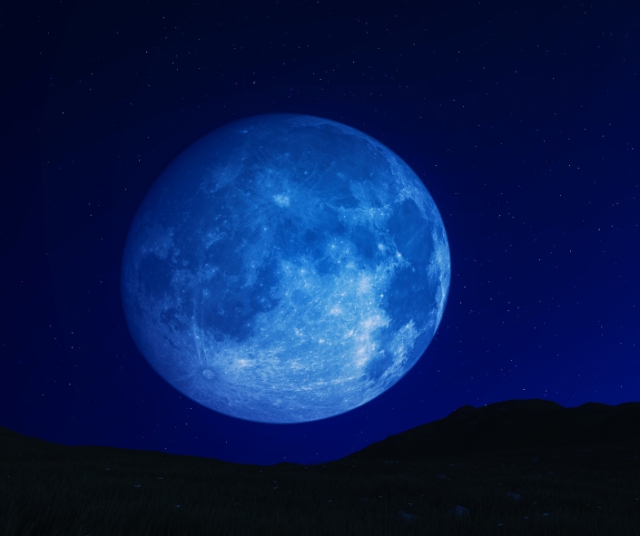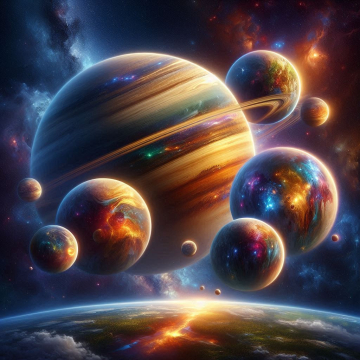The Moon has fascinated humanity throughout history. Its mystery, its beauty and its influence on life on Earth have made it an object of study and adoration. Over the centuries, we have observed various lunar phases, from the new moon to the full moon, but there is one phase that stands out for its rarity and its intriguing name: the Blue Moon.
Before delving into the Blue Moon phenomenon, it is important to understand the different lunar phases and how they occur. The Moon, as Earth's natural satellite, undergoes a continuous cycle of phases as it orbits our planet. These phases are due to the relative position of the Moon, Earth and Sun.
The most common lunar phases are:
New Moon: In this phase, the Moon is between the Earth and the Sun, making its illuminated side not visible from Earth.
First Quarter: The Moon begins to grow and lights up by 50%. In this phase, we see the right half of the Moon illuminated.
Full Moon: In this phase, the Moon is on the opposite side of the Earth to the Sun, making it appear completely illuminated from the Earth.
Last Quarter: The Moon decreases its illumination by 50%. In this phase, we see the left half of the Moon illuminated.
These four phases are the best known and occur approximately every 7 days. However, the Moon also goes through other phases, such as gibbous moons and crescent moons, which are a transition between the main phases. But on rare occasions, an event occurs that captures the imagination of many people: the Blue Moon.
What is a Blue Moon?
The Blue Moon is an additional lunar phase that occurs occasionally in a calendar month. It is said that a Blue Moon occurs when there are two full moons in the same month. It should be noted that the Moon does not turn blue in this event, despite its name. The name "Blue Moon" originated in calendrical terms and has no relation to the color of the Moon.
The expression "Blue Moon" has an intriguing history dating back to the 16th century. It was used to describe rare or improbable events, since the occurrence of two full moons in a single month was not common. The word "blue" was used to denote something strange or rare, and so the Blue Moon became a term that represented a rare phenomenon.
In 1946, Sky & Telescope magazine published an article that reinterpreted the definition of a Blue Moon as two full moons in a calendar month. This new definition became widely accepted and is the one we use today.
The Moon Does Not Change Color
It is important to clarify that the Blue Moon does not acquire a blue tone in its appearance. The Moon can turn blue under very unusual circumstances, such as when there are particles in the atmosphere that scatter light and allow only blue wavelengths to reach our eyes. However, this is extremely rare and has no relation to the Blue Moon phenomenon in calendar terms.
How Often Does a Blue Moon Occur?
The average lunar cycle is approximately 29.5 days. This means that in most months there is room for only one full moon. However, due to differences in the length of months in the Gregorian calendar, there can sometimes be two full moons in one month, giving rise to the Blue Moon.
The Blue Moon phenomenon does not have a fixed frequency. On average, it occurs about every 2.7 years, which means that, on average, there is a Blue Moon about every 2 years and 8 months. The variability is due to differences in the length of the months and how they align with the lunar cycle.
Meaning and Myths of the Blue Moon
The Moon has been an object of fascination, adoration and mythology in various cultures throughout history. The Blue Moon, being a rare event, has accumulated its own set of meanings and myths over the years.
Meaning in Popular Culture
The Blue Moon is often associated with rarity and the unusual. Some people believe that it is an auspicious time to make special wishes or rituals, as energies are believed to be at their highest during this period. It has also been considered a time of reflection and spiritual renewal.
Myths and legends
In the mythology of different cultures, the Moon has played a prominent role. The Blue Moon, as a celestial rarity, is often linked to significant events and changes in legends. For example, in some Native American traditions, a Blue Moon is believed to be a time when the spirits of ancestors are especially present and more likely to communicate with the living.
In contemporary popular culture, the Blue Moon has also inspired songs, films and works of art that capture its mystery and beauty. It is a recurring theme in music, from the famous song "Blue Moon" by The Marcels to references in songs of various genres.
Interesting Facts about the Blue Moon
The Blue Moon is a fascinating phenomenon that goes beyond its symbolic and mythological aspect. Here are some interesting facts about this lunar event:
Double Events
The Blue Moon occurs when there are two full moons in the same month. This means that, by definition, it always occurs on the last day of the month. The first full moon of the month is what is often known as the "true full moon," while the second is what is called the Blue Moon.
Colloquially, "Once in a Blue Moon"
The expression "Once in a Blue Moon" is used to describe extremely rare or infrequent events. This expression originates from the rarity of the Blue Moon, which, as we have mentioned, occurs approximately every 2 years and 8 months.
Versatile Phenomenon
The modern definition of a Blue Moon based on the Gregorian calendar has led to the creation of other similar definitions for other lunar months. For example, a "Black Moon" refers to the absence of a new moon in a calendar month, which occurs approximately once every 29 months.
How to Observe a Blue Moon
The Blue Moon is a beautiful natural phenomenon that is worth observing if you have the opportunity. Here are some tips to enjoy the Blue Moon:
Consult the Lunar Calendar
If you want to know when the next Blue Moon will occur, consult a lunar calendar or moon tracking app. These resources will provide you with information about the exact dates and times of the moon phases.
Find a Dark Place
To fully appreciate the beauty of the Blue Moon, find a dark place away from city light pollution. This will allow you to enjoy a clearer sky and the Moon at its maximum splendor.
Use a Telescope or Binoculars
If you want to observe the Blue Moon in detail, consider using a telescope or good binoculars. This will allow you to see craters, mountains, and other features of the lunar surface more clearly.
Share the Moment
Observing the Blue Moon can be a special experience. Invite friends or family to join you to enjoy this unique lunar event and share stories and myths about the Moon.
In its silver light, we find the promise of the unknown and the beauty of the unattainable, reminding us that, even in the modern era, the cosmos remains a place full of wonders and mysteries to discover. The Blue Moon endures as an eternal reminder of our eternal fascination with space and our never-ending quest to understand the mysteries of the universe.






